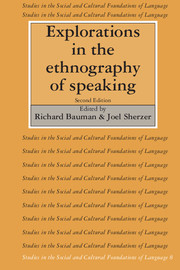Book contents
- Frontmatter
- Contents
- INTRODUCTION TO THE SECOND EDITION
- I PREFACE AND INTRODUCTION
- II COMMUNITIES AND RESOURCES FOR PERFORMANCE
- III COMMUNITY GROUND RULES FOR PERFORMANCE
- IV SPEECH ACTS, EVENTS, AND SITUATIONS
- Introduction
- 8 Strategies of Status Manipulation in the Wolof Greeting
- 9 Rituals of Encounter among the Maori: Sociolinguistic Study of a Scene
- 10 Speaking of Speaking: Tenejapa Tzeltal Metalinguistics
- 11 Black Talking on the Streets
- 12 Namakke, Sunmakke, Kormakke: Three Types of Cuna Speech Event
- 13 The Concept and Varieties of Narrative Performance in East European Jewish Culture
- V THE SHAPING OF ARTISTIC STRUCTURES IN PERFORMANCE
- VI TOWARD AN ETHNOLOGY OF SPEAKING
- Notes
- References
- Index of names
Introduction
Published online by Cambridge University Press: 05 June 2012
- Frontmatter
- Contents
- INTRODUCTION TO THE SECOND EDITION
- I PREFACE AND INTRODUCTION
- II COMMUNITIES AND RESOURCES FOR PERFORMANCE
- III COMMUNITY GROUND RULES FOR PERFORMANCE
- IV SPEECH ACTS, EVENTS, AND SITUATIONS
- Introduction
- 8 Strategies of Status Manipulation in the Wolof Greeting
- 9 Rituals of Encounter among the Maori: Sociolinguistic Study of a Scene
- 10 Speaking of Speaking: Tenejapa Tzeltal Metalinguistics
- 11 Black Talking on the Streets
- 12 Namakke, Sunmakke, Kormakke: Three Types of Cuna Speech Event
- 13 The Concept and Varieties of Narrative Performance in East European Jewish Culture
- V THE SHAPING OF ARTISTIC STRUCTURES IN PERFORMANCE
- VI TOWARD AN ETHNOLOGY OF SPEAKING
- Notes
- References
- Index of names
Summary
One of the most central concerns of the ethnography of speaking is the description of speech acts, events, and situations. All of the papers in the book deal with it in some way, but for the papers in this section it is the primary focus of attention.
Most formal description within linguistics has been limited to units of sentence length. With this limitation, insights have been achieved in the techniques and theory of linguistic formalization. Yet there is much more to language use than abstract, isolated sentences; and such uses of language as greetings, leave-takings, conversations, speeches, stories, insults, jokes, and puns also have a formal structure. The papers in this section by Judith Irvine and Anne Salmond are examples of the kinds of formal descriptions that can be written for discourse. Irvine provides a grammar of Wolof greetings; Salmond, of an entire Maori speech situation, the ritual of encounter. Rules which formally describe speech acts, events, and situations must include aspects of language and speech which have usually been ignored in traditional grammatical descriptions. Most obvious is perhaps the participants in the event. The grammatical descriptions by Irvine and Salmond are written not from the perspective of a single, isolated, abstract individual, but rather from that of all of the participants in the event. The participants in the Wolof greeting, and especially their social ranking with respect to one another, are incorporated into the greeting rules.
- Type
- Chapter
- Information
- Explorations in the Ethnography of Speaking , pp. 163 - 166Publisher: Cambridge University PressPrint publication year: 1989

